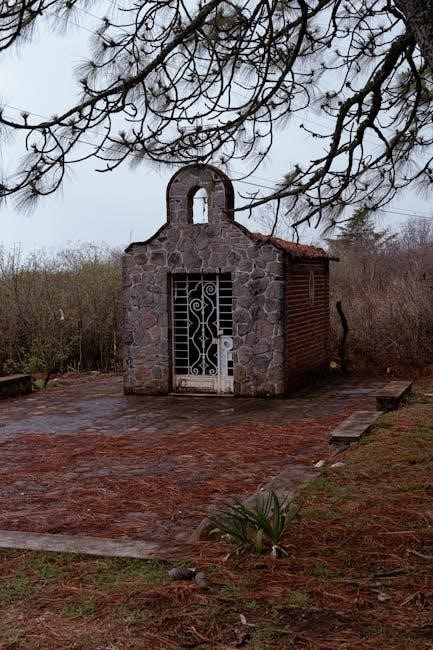A Transfer on Death Deed in New Mexico is a legal tool allowing property owners to transfer real estate to beneficiaries upon death, bypassing probate, while retaining control during their lifetime.
1.1 Definition and Purpose of a Transfer on Death Deed
A Transfer on Death Deed is a legal instrument in New Mexico that enables property owners to designate a beneficiary to inherit real estate upon their death. Its primary purpose is to bypass probate, ensuring a seamless transfer of ownership while allowing the grantor to retain full control and the ability to revoke or modify the deed during their lifetime.
1.2 Importance of Estate Planning with a TOD Deed
Estate planning with a Transfer on Death Deed in New Mexico simplifies property transfer upon death, bypassing probate. It ensures real estate passes to beneficiaries according to the owner’s wishes, maintaining control during their lifetime. This tool offers flexibility as it is revocable, making it an essential component of a comprehensive estate plan.
Benefits of Using a Transfer on Death Deed
A Transfer on Death Deed in New Mexico offers benefits like avoiding probate, retaining control during lifetime, and ensuring property transfers according to the owner’s wishes.
2.1 Avoiding Probate
A key benefit of a Transfer on Death Deed in New Mexico is that it allows real property to bypass probate, ensuring a faster and more cost-effective transfer process. By avoiding probate court, beneficiaries receive the property directly, eliminating delays and legal complexities associated with estate administration. This streamlined process ensures the grantor’s wishes are carried out efficiently and without court intervention.
2.2 Retaining Control Over Property During Lifetime
One of the most significant advantages of a Transfer on Death Deed is that it allows the grantor to retain full control and ownership of the property during their lifetime. The grantor can sell, mortgage, or use the property as they wish without requiring beneficiary consent. This ensures the property remains entirely under the grantor’s authority until their death, providing flexibility and peace of mind.
2.3 Revocable Nature of the Deed
A key feature of a Transfer on Death Deed is its revocable nature, allowing the grantor to revoke or modify the deed at any time before death. This flexibility ensures the grantor retains control and can change beneficiaries or revoke the deed entirely without requiring consent. The deed remains in effect only if the grantor dies, providing peace of mind and adaptability.

How a Transfer on Death Deed Works
A Transfer on Death Deed is executed and recorded during the grantor’s lifetime. It ensures property transfers to beneficiaries upon death, bypassing probate, while the grantor retains control until then.
3.1 Execution and Recording of the Deed
A Transfer on Death Deed must be executed by the grantor, notarized, and recorded with the county clerk to be valid. The process involves signing the deed, having it notarized, and filing it with the appropriate county office; This ensures the deed is legally recognized and revocable during the grantor’s lifetime, allowing for changes or cancellations before death. Upon the grantor’s passing, the property seamlessly transfers to the designated beneficiary without probate.
3.2 Effect of the Deed at the Time of Death
Upon the grantor’s death, the Transfer on Death Deed automatically transfers ownership of the property to the named beneficiary. The deed ensures a seamless transition without probate, allowing the beneficiary to assume ownership immediately. The beneficiary gains full rights to the property as of the grantor’s death, avoiding legal complexities and ensuring a smooth inheritance process.
3.3 Revocation Process
A Transfer on Death Deed in New Mexico is revocable. The grantor may revoke it at any time before death by completing a revocation form and recording it with the county clerk. This action cancels any prior beneficiary designations, ensuring the grantor retains control over the property’s distribution.

Legal Requirements for a Transfer on Death Deed in New Mexico
A Transfer on Death Deed in New Mexico requires proper execution, naming a beneficiary, and recording with the county clerk to ensure validity and legal recognition.
4.1 Naming a Beneficiary
A Transfer on Death Deed requires the grantor to clearly designate a beneficiary to inherit the property. The beneficiary can be an individual, multiple parties, or a class (e.g., children). The designation must be explicit, and the beneficiary’s rights take effect only upon the grantor’s death. The deed revokes all prior beneficiary designations for the specified property, ensuring clarity in ownership transfer. New Mexico law mandates that the beneficiary’s name and legal description of the property be included in the deed for validity.
4.2 Property Description and Legal Formalities
A Transfer on Death Deed in New Mexico requires a precise legal description of the property, including its address and boundaries, to ensure clarity. The deed must state that the transfer occurs only upon the grantor’s death. Proper formatting, adherence to state statutes, and recording with the county clerk are essential for validity. It revokes all prior beneficiary designations for the described property.
4.3 Recording the Deed with the County Clerk
Recording a Transfer on Death Deed with the county clerk in New Mexico is essential for its validity. The deed must be submitted to the appropriate county office, accompanied by required fees and documentation. This step ensures the transfer is legally recognized. Failure to record the deed may result in the transfer not being honored, delaying the beneficiary’s rights to the property. Proper recording finalizes the deed’s enforceability upon the grantor’s death.
Step-by-Step Guide to Creating a Transfer on Death Deed
Create a Transfer on Death Deed by drafting the document with property details and beneficiary information. Sign it in the presence of a notary and record it with the county clerk to ensure legal validity and enforceability upon the grantor’s death.
5.1 Drafting the Deed
Drafting a Transfer on Death Deed requires including the grantor’s and beneficiary’s full legal names, a detailed property description, and specific language indicating the transfer occurs at death. The deed must state it is revocable and does not affect the grantor’s rights during their lifetime. Ensure compliance with New Mexico’s legal requirements for clarity and enforceability.
5.2 Signing and Notarizing the Document
The grantor must sign the Transfer on Death Deed in the presence of a notary public to ensure its validity. The notary verifies the grantor’s identity and witnesses the signature, adhering to New Mexico’s legal requirements. This step is essential to make the deed legally binding and enforceable, ensuring the transfer process proceeds smoothly after the grantor’s death.
5.3 Submitting the Deed for Recording
After signing and notarizing, the deed must be submitted to the County Clerk’s office in the county where the property is located. The recording process ensures the deed becomes part of public records, making it legally recognized. This step is crucial for the seamless transfer of ownership upon the grantor’s death, as it prevents future disputes and ensures the beneficiary’s rights are protected.

Advantages and Disadvantages of a Transfer on Death Deed
A Transfer on Death Deed simplifies estate planning by avoiding probate and retaining control over property during the grantor’s lifetime. However, it offers limited flexibility in terms of conditional transfers or multiple beneficiary designations, requiring careful planning to align with overall estate goals.
6.1 Advantages: Simplified Estate Planning
A Transfer on Death Deed offers a straightforward method for estate planning, allowing property owners to bypass probate and ensure seamless transfer of real estate to beneficiaries. It maintains the grantor’s control during their lifetime and provides the flexibility to revoke or amend the deed as needed, making it an efficient tool for organizing asset distribution without legal complexities.
6.2 Disadvantages: Limited Flexibility
While a Transfer on Death Deed simplifies estate planning, it lacks flexibility for complex situations. It cannot divide property among multiple beneficiaries with specific shares or address contingent interests. Changes require revoking the deed, and if the beneficiary predeceases the grantor, the property may not transfer as intended without additional legal steps, limiting its adaptability to evolving family dynamics.
The Process After the Owner’s Death
Upon the owner’s death, the beneficiary assumes ownership of the property as outlined in the Transfer on Death Deed. No probate is required, and the transfer is finalized through legal documentation, ensuring a seamless transition of title to the designated beneficiary.
7.1 Role of the Beneficiary
The beneficiary inherits the property automatically upon the grantor’s death, as per the Transfer on Death Deed. They receive ownership without the need for probate, ensuring a seamless transition. The beneficiary must provide a certified death certificate to formalize the transfer, upholding the grantor’s wishes efficiently.
7.2 Legal Steps to Transfer Ownership
After the grantor’s death, the beneficiary must file the death certificate with the county clerk. The beneficiary then prepares and submits the necessary legal documents to formalize ownership. This includes completing any required paperwork and paying applicable fees. The county clerk records the transfer, ensuring the property legally transitions to the beneficiary as outlined in the deed.

Estate Planning Considerations with a Transfer on Death Deed
A Transfer on Death Deed simplifies estate planning by allowing property transfer without probate, but it is revocable and must be coordinated with other estate tools like wills or trusts.
8.1 Coordinating with Other Estate Planning Tools
A Transfer on Death Deed works seamlessly with other estate planning tools, such as wills, trusts, and beneficiary designations. It ensures property transfers are aligned with overall estate goals, avoiding conflicts and probate. Proper coordination guarantees a cohesive plan, maintaining control and flexibility during the grantor’s lifetime while providing clarity for beneficiaries after death. Legal advice is recommended for optimal integration.
8.2 Limitations of a TOD Deed
A Transfer on Death Deed only applies to real property and does not cover other assets. It cannot be used to transfer property with shared ownership without consent. Beneficiaries inherit the property “as is,” including liens or mortgages. Changes require formal legal steps, limiting flexibility. It does not address debts or tax implications, making it essential to integrate with a comprehensive estate plan for full coverage.
Comparison with Other Property Transfer Methods
A Transfer on Death Deed differs from wills and trusts by bypassing probate and retaining control during the grantor’s lifetime, offering a simpler, more direct estate planning solution.
9.1 Transfer on Death Deed vs. Will
A Transfer on Death Deed bypasses probate and retains control over property during the grantor’s lifetime, unlike a will, which requires probate and cannot revoke property transfers. While a will covers all assets and estate matters, a TOD Deed is specifically for real estate, offering a streamlined, efficient way to transfer property at death without court involvement.
9.2 Transfer on Death Deed vs. Trust
A Transfer on Death Deed is simpler and less flexible than a trust, as it solely transfers real property at death. Unlike a trust, it does not allow for conditional distributions or management of assets. While both avoid probate, a trust offers more control over asset distribution and can cover multiple types of property, making it suitable for more complex estate planning needs.

Sample Language from a New Mexico Transfer on Death Deed
This section includes the legal language used in a New Mexico Transfer on Death Deed, specifying that the deed is revocable and does not transfer ownership until the grantor’s death, ensuring the grantor retains full ownership and control during their lifetime.
10.1 Grantor and Beneficiary Information
The deed includes the grantor’s name, address, and the beneficiary’s full name and address. It specifies the property’s legal description, ensuring clarity in ownership transfer. The grantor retains control until death, with the beneficiary’s rights activating only posthumously. This section is essential for validating the deed’s authenticity and ensuring a seamless transfer process as per New Mexico state law requirements. The information provided must be accurate and complete to avoid legal disputes.
10.2 Property Description and Legal Terms
The deed must include a detailed legal description of the property, referencing title reports or prior deeds. It specifies that the transfer applies only to surface rights, excluding mineral or subsurface rights. The document also includes language revoking prior beneficiary designations and clarifying that the beneficiary inherits the property “as is,” subject to existing liens or mortgages, ensuring legal compliance and clarity. This section ensures the transfer is legally binding and unambiguous.
County-Specific Requirements for Recording
Recording a Transfer on Death Deed in New Mexico requires submitting the deed to the county clerk, including filing fees and required documentation for legal validation and accuracy.
11.1 Filing Fees and Procedures
Recording a Transfer on Death Deed in New Mexico requires submitting the deed to the county clerk, along with the appropriate filing fees. The process involves delivering the notarized deed, ensuring all legal formalities are met, and paying the required fees to validate the document officially.
11.2 Required Documentation
To record a Transfer on Death Deed in New Mexico, the grantor must provide the notarized deed, a valid government-issued ID, and a detailed property description. The document must be signed in the presence of a notary public and submitted to the county clerk for recording. Additional documentation, such as a death certificate, is required after the grantor’s passing to finalize the transfer.
Tax Implications of a Transfer on Death Deed
A Transfer on Death Deed in New Mexico may impact property taxes after the transfer. Estate taxes could apply, though the revocable nature may exclude it from the taxable estate.

12.1 Property Tax Considerations
A Transfer on Death Deed in New Mexico may impact property taxes after the transfer. The beneficiary inherits the property with its current tax basis, potentially avoiding reassessment. However, local tax laws may influence whether the transfer triggers any changes. Consulting a tax professional is advisable to understand specific implications for the beneficiary and the estate.
12.2 Estate Tax Implications
The Transfer on Death Deed in New Mexico ensures the property’s value is included in the grantor’s taxable estate at death, potentially impacting federal and state estate taxes. Beneficiaries may benefit from a step-up in basis, reducing capital gains taxes if the property is sold. Consulting a tax professional is essential to navigate these implications effectively.

Revoking or Amending a Transfer on Death Deed
A Transfer on Death Deed can be revoked or amended during the grantor’s lifetime by executing a new deed, ensuring flexibility and control over property distribution until death.
13.1 Process for Revocation
To revoke a Transfer on Death Deed in New Mexico, the grantor must execute a new deed or legal instrument explicitly revoking the original deed. The revocation must be recorded with the county clerk to ensure its validity. The original deed is clearly identified to avoid ambiguity. Recording the revocation ensures the property transfer is canceled, maintaining the grantor’s control and preventing unintended ownership changes.
13.2 Making Changes to Beneficiary Designations
To modify beneficiary designations in a Transfer on Death Deed, the grantor must execute a new deed or a revocation form. The updated document must be recorded with the county clerk to ensure legal recognition. This process allows the grantor to adjust beneficiaries as needed, maintaining flexibility in estate planning. Changes are only effective upon proper recording.

Frequently Asked Questions About Transfer on Death Deeds
- Can a TOD Deed Be Used for Multiple Properties? Yes, a Transfer on Death Deed can cover multiple properties in New Mexico if properly described and recorded.
- What Happens If the Beneficiary Predeceases the Grantor? If a beneficiary dies before the grantor, their interest passes to their heirs or as specified in the deed.
14.1 Can a TOD Deed Be Used for Multiple Properties?
A Transfer on Death Deed in New Mexico can indeed cover multiple properties, provided each parcel is accurately described and the deed is properly recorded. This allows grantors to efficiently manage the transfer of multiple assets to beneficiaries without requiring separate deeds for each property, simplifying the estate planning process while maintaining control during their lifetime.
14.2 What Happens If the Beneficiary Predeceases the Grantor?
If a beneficiary named in a New Mexico Transfer on Death Deed predeceases the grantor, their interest in the property typically lapses. The property may pass to other named beneficiaries or revert to the grantor’s estate, depending on the deed’s terms. To avoid unintended outcomes, it’s crucial to update the deed and name alternative beneficiaries, ensuring the grantor’s wishes are fulfilled. Legal advice is recommended to address such scenarios effectively.
A New Mexico Transfer on Death Deed simplifies estate planning by allowing property owners to transfer real estate directly to beneficiaries without probate, ensuring their wishes are honored efficiently.
15.1 Summary of Key Points
A Transfer on Death Deed in New Mexico is a legal tool enabling property owners to transfer real estate to beneficiaries upon death, bypassing probate. It allows the grantor to retain control during their lifetime and revoke the deed if needed. This estate planning instrument ensures a seamless transition of ownership, avoiding costly and time-consuming legal processes, while respecting the owner’s wishes for property distribution.

15.2 Importance of Professional Legal Advice
Consulting a legal professional is crucial when creating a Transfer on Death Deed in New Mexico. An attorney ensures the deed aligns with your intentions, complies with state laws, and integrates with your broader estate plan. Legal expertise helps navigate complexities, prevent potential disputes, and guarantee the deed’s validity, providing peace of mind for a smooth property transfer process.
